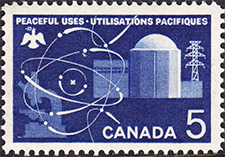Peaceful Uses - 5 cents 1966 - Canadian stamp
Specifications
- Quantity: 25 360 000
- Issue date: July 27, 1966
- Printer: Canadian Bank Note Company, Limited.
- Perforation: 12
- Scott: #449
Peaceful Uses - 5 cents 1966 prices and values
The value of a Peaceful Uses - 5 cents 1966 stamp depends on several factors such as quality and wear, supply and demand, rarity, finish and more. Values in the section are based on the market, trends, auctions and recognized books, publications and catalogs. This section also includes information on errors and varieties and characteristics.

- Used
- Mint
- With gum - Never Hinged
| VG | F | VF | FDC | |
|---|---|---|---|---|
| Peaceful Uses - 5 cents 1966 | $0.02 | $0.04 | $0.07 | $1.20 |
| VG | F | VF | |
|---|---|---|---|
| Peaceful Uses - 5 cents 1966 | $0.03 | $0.05 | $0.09 |
| VG | F | VF | |
|---|---|---|---|
| Peaceful Uses - 5 cents 1966 | $0.05 | $0.10 | $0.18 |
Description
With the issue of this stamp, the Post Office Department payed tribute to the effort being made by world scientists towards the development of peaceful uses of atomic energy. The role of Canada in this world endeavour was considerable. Canadian scientists for example, were working in the fields of materials science and in engineering research. Work was done in biology and health physics, in the development of cancer therapy units, and on the biological effects of radiation. Physicists at remote northern points were involved in the International Quiet Sun Years Programme, with the aim of studying variations in intensity of cosmic rays during this period of minimum activity of the sun. From Point Pelee, Ontario, to Alert, N.W.T., in isolated communities and in metropolitan centres, Canadian scientists were attempting to create new ways to utilize the powerful forces of atomic energy. One of the most heralded uses of atomic energy has been in the field of electricity generation.
Naturally enough, researchers over the world have developed different types of nuclear reactors to produce electric power. For her part, Canada has followed a route of power reactor development that was uniquely different from the major programs in most other nuclear advanced countries; a system based on the use of natural uranium fuel, and heavy water as a moderator and coolant. The first full-scale nuclear power plant in the country, Douglas Point was a reactor known by the code name CANDU, or Canadian Deuterium Uranium. The Douglas Point station, located in Ontario on the shores of Lake Huron, can produced 200,000 kilowatts of electricity from one unit - enough to supply a city the size of Ottawa in 1966. And its use was not limited to basic electricity production. As a full-scale prototype, it was a fore-runner of even larger stations such as the Pickering Generating Station; a million kilowatt nuclear power station scheduled for completion in 1970-72. The CANDU principle has been employed in a reactor being built by India, and plans were made for a heavy water reactor of a similar type at Karachi, Pakistan. This stamp features symbols of some of the major contributions Canada was making to atomic energy research. A stylized representation of the Douglas Point Nuclear Station is shown, together with a microscope symbolizing research, and the chemical symbol for a heavy water atom. In the upperleft corner is the dove of peace emphasizing the purpose to which this development was devoted.
Creators
Designed by Alan L. Pollock
Picture engraved by Yves Baril
Lettering engraved by Donald J. Mitchell
Right now on Ebay (Ad)
Stampsandcanada.com is supported by its audience. When you buy through links on our site, we may earn a commission.
See more »Note
The values on this page are in Canadian dollars (CAD).

